
* Although the USA was the leader in helicopter development after World War II, Europe wasn't far behind. In the mid-1950s, the French firm Sud Aviation -- later Aerospatiale, then part of Eurocopter, now Airbus Helicopter -- scored a significant success in the helicopter business with the "Alouette II" light helicopter and its refined "Alouette III" derivative. In the late 1960s, the firm would rethink the Alouette design to come up with the modernized "Gazelle" light helicopter, which would also prove a major success. This document provides a history and description of the Alouette / Gazelle helicopter family. A list of illustration credits is provided at the end.
* In the early 1950s, the French Societe Nationale de Constructions Aeronautiques du Sud-Est (SNCASE, or just "Sud-Est / Southeast") conducted test flights of the piston-powered "SE 3110" and "SE 3120 Alouette (Lark)" helicopters. Sources are contradictory concerning details of these machines, but they were roughly in the class of the contemporary US Bell Model 47 and Hiller Model 360 helicopters, being powered by a Salmson 9NH radial piston engine providing 150 kW (200 HP).
They remain obscure because they never reached production. Sud-Est perceived that the future of rotorcraft lay with turbine propulsion, and so the company focused development efforts on a turboshaft-powered design, the "SE 3130 Alouette II". Initial flight of the first of two SE 3130 prototypes, powered by a single Turbomeca Artouste I engine providing 270 kW (360 SHP), was on 12 March 1956. French certification was awarded on 2 May 1956, paving the way for production deliveries. Less than a year later, in March 1957, Sud-Est merged with Sud-Ouest, another French aviation firm, to become "Sud Aviation". The Alouette II would become a very successful product for the reborn firm.
* The SE 3130 -- later designated "SE 313B" -- had a general configuration clearly reminiscent of the Bell 47 and the Hiller 360, being a light helicopter of conventional main-tail rotor configuration with a bubble-type cockpit, a framed tailboom, and skid landing gear. However, along with turboshaft propulsion, the Alouette II was a more capable machine, with a capacity of five -- two in front bucket seats, and three seated across in the rear. The cockpit could also be configured for a pilot, two stretchers carried internally, and a medical attendant. The Alouette II could carry external sling loads of up to 500 kilograms (1,100 pounds).
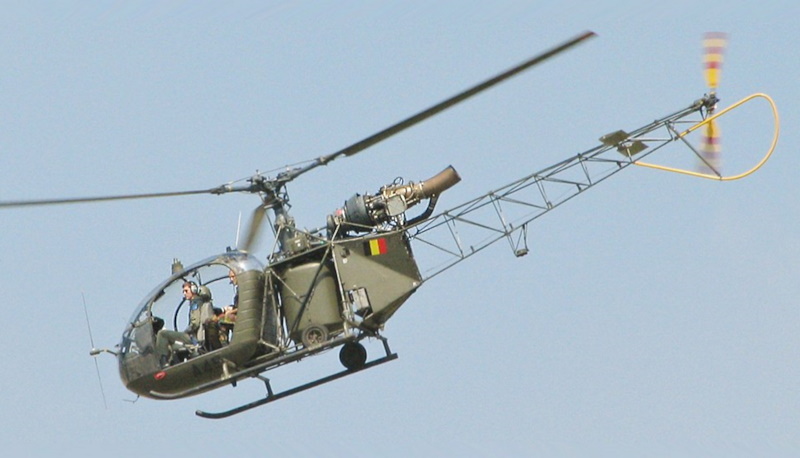
The SE 3130 featured a three-bladed main rotor and a two-bladed tail rotor, all made of metal, with a frame guard protecting the tail rotor from ground strikes. The rotor blades could be manually folded for storage and transport. The production SE 3130 was powered by a Turbomeca Artouste IIC6 turboshaft engine, with the same ratings as the Artouste I, the engine being perched just behind the rotor mast.
___________________________________________________________________
SUD SE 3130 (SE 313B) ALOUETTE II:
___________________________________________________________________
main rotor diameter:
10.2 meters (33 feet 6 inches)
tail rotor diameter:
1.81 meters (5 feet 11 inches)
fuselage length:
9.75 meters (32 feet)
footprint length:
12.1 meters (39 feet 9 inches)
height (rotor head):
2.75 meters (9 feet)
empty weight:
895 kilograms (1,975 pounds)
max loaded weight:
1,600 kilograms (3,525 pounds)
maximum speed:
185 KPH (115 MPH / 100 KT)
service ceiling:
2,150 meters (7,050 feet)
hover ceiling (in ground effect):
1,550 meters (5,085 feet)
hover ceiling (out of ground effect):
900 meters (2,955 feet)
range (normal load):
300 kilometers (185 MI / 160 NMI)
___________________________________________________________________
There was a tailplane on the tailboom just forward of the tail rotor. Access to the cockpit was through a single large forward-hinged door on each side. A fuel tank was mounted behind the cockpit. Each landing skid featured a swing-down wheel near the rear for ground handling. Wheeled or pontoon landing gear could be fitted as options; a rescue hoist with a 120-kilogram (265-pound) load capacity was also available as an option. Armament was fitted to the SE 3130 as well, in the form of twin Nord SS-11 wired-guided antitank missiles, but apparently that was just a trials configuration -- the Alouette II was a bit on the light side to be an adequate battlefield helicopter, and it is difficult to find evidence that it was ever seriously used in combat as a weapons platform.
* The Alouette II proving successful, Sud Aviation began to consider a "growth" derivative with a more powerful engine and a proper fuselage with a skinned instead of framed tailboom. The fuselage was an outgrowth of work performed on an executive version of the Alouette II featuring a fuselage named the "Governeur", with a single prototype built and performing test flights in 1957. Initial flight of the "SE 3160 Alouette III" -- powered by a Turbomeca Artouste IIIB turboshaft with 410 kW (550 SHP) -- was on 28 February 1959, leading to initial production deliveries in 1961.
The SE 3160 -- later redesignated the "SA 316A" -- was clearly a relative of the Alouette II, both helicopters having the same general arrangement, with a three-blade main rotor and the engine situated behind the rotor mast -- though the tail rotor of the Alouette III had three blades instead of two. As noted, the Alouette III had a complete full fuselage; it also featured a tailfin plate at the end of each tailplane, and fixed wheeled tricycle landing gear. Skis could be optionally fitted over the wheels for operation in snow or soft ground.
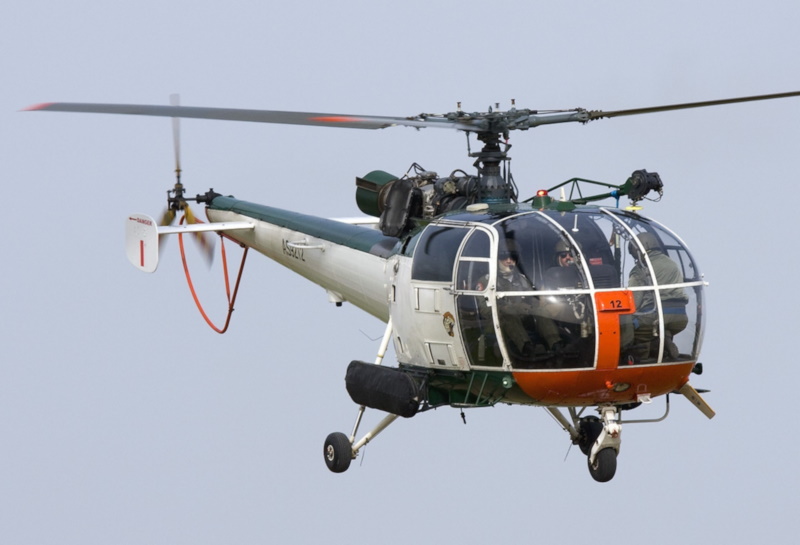
The cabin was enlarged, with a forward-hinged door in front and a backwards-sliding door in the rear on each side. The cabin could carry a pilot and seven passengers, with three seats up front and a folding seat for up to four in the rear. Seats could be removed for cargo carriage; and the cabin could be configured for a pilot plus two stretchers and two medical attendants. There were twin baggage holds behind the passenger compartment. The Alouette III could haul external sling loads of up to 750 kilograms (1,650 pounds).
___________________________________________________________________
SUD SE 3160 (SE 316A) ALOUETTE III:
___________________________________________________________________
main rotor diameter:
11.02 meters (36 feet 2 inches)
tail rotor diameter:
1.91 meters (6 feet 4 inches)
fuselage length:
10.03 meters (32 feet 11 inches)
footprint length:
12.84 meters (42 feet 2 inches)
height (rotor head):
3.0 meters (9 feet 10 inches)
empty weight:
1,100 kilograms (2,445 pounds)
max loaded weight:
2,100 kilograms (4,630 pounds)
maximum speed:
210 KPH (130 MPH / 115 KT)
service ceiling:
4,250 meters (13,950 feet)
hover ceiling (in ground effect):
3,100 meters (10,170 feet)
hover ceiling (out of ground effect):
1,700 meters (5,575 feet)
range (normal load):
300 kilometers (185 MI / 160 NMI)
___________________________________________________________________
Although the Alouette II was rarely if ever used as an armed helicopter, the Alouette III was operationally flown in armed configurations, and saw a fair amount of combat. Weapons configurations included:
While "Eurojokes" circulate about French technology, the Alouette series would become established as a good buy, providing capability, reliability, and maintainability at a good price. The Alouette would become a familiar rotorcraft in many nations outside the Eastern Bloc.
BACK_TO_TOP* The Alouette II remained in production as a lower-cost, less capable product alongside the Alouette III, with both series being updated in parallel. Consideration was given to developing an "SE 3140 Alouette II" -- much the same as the SE 3130, the difference being with a Turbomeca Turmo II engine providing 300 kW (400 SHP) -- but it didn't happen, Sud leveraging off the Turbomeca Astazou IIA instead, resulting in the first flight of the "SE 3180 Alouette II Astazou" on 31 January 1961. The SE 3180 Alouette II Astazou received its French certification in early 1964 as the "SA 318C Alouette II", and went into production in 1965. The production machine was powered by the Astazou IIA engine with 410 kW (550 SHP).
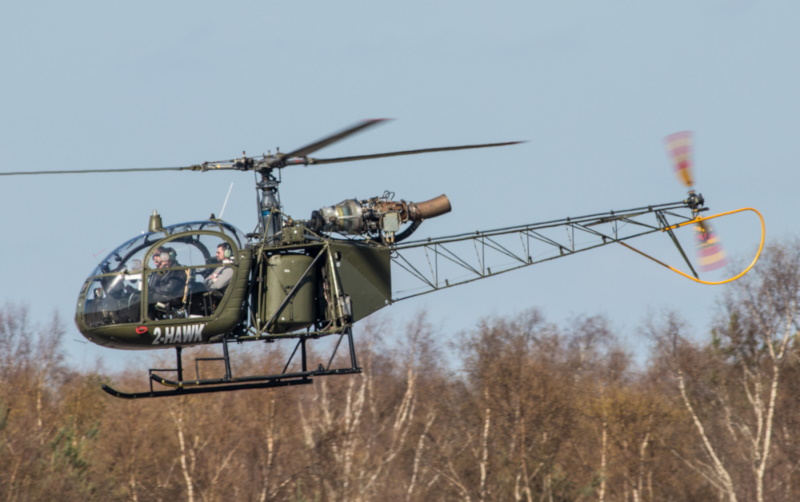
* A modestly revised variant of the Alouette III, the "SA 316B", was first flown on 27 June 1968; it was very difficult to distinguish from the SA 316A and retained the Artouste IIIB engine, the main difference being a stronger rotor system to allow it to carry more payload. Hindustan Aircraft LTD (HAL) of India acquired a license to build the SA 316B Alouette III as the "Chetak", with the first HAL-assembled machine performing its first flight in 1965. ICA-Brasov, later IAR, of Romania also obtained a license to build the SA 316B, manufacturing it as the "IAR 316B".
Sud then introduced an "SA 316C" variant was introduced that had the uprated Artouste IIID engine, but was only built in small numbers. However, a parallel effort to build an Alouette III variant with a Turbomeca Astazou XIV turboshaft, providing 450 kW (600 SHP), worked out better. Following flight of a prototype in 1967, this variant did reach full production as the "SA 319B Alouette III Astazou". Apparently, HAL Chetak production moved on to that variant as well.
The SA 319B Alouette III could be fitted with French OMERA ORB 31 radar for maritime warfare, accommodated in a bulbous nose fairing attached to the front cockpit glazing, possibly along with a towed MAD sensor. This appears to have been an unusual fit, operated in small numbers by the French, Greek, Indian, and South Korean navies.
BACK_TO_TOP* The last member of the Alouette family to reach full production was the "SA 315B Lama", effectively a "hot & high" version of the Alouette II developed at the request of the Indian military, which has to conduct operations in high mountain regions. The Lama was something of a hybrid, featuring the airframe of the SA 313B Alouette II with some reinforcement, and the Artouste IIIB engine and rotor system of the SA 316B Alouette III. Initial flight of the prototype was on 17 March 1969, with production beginning in 1972.
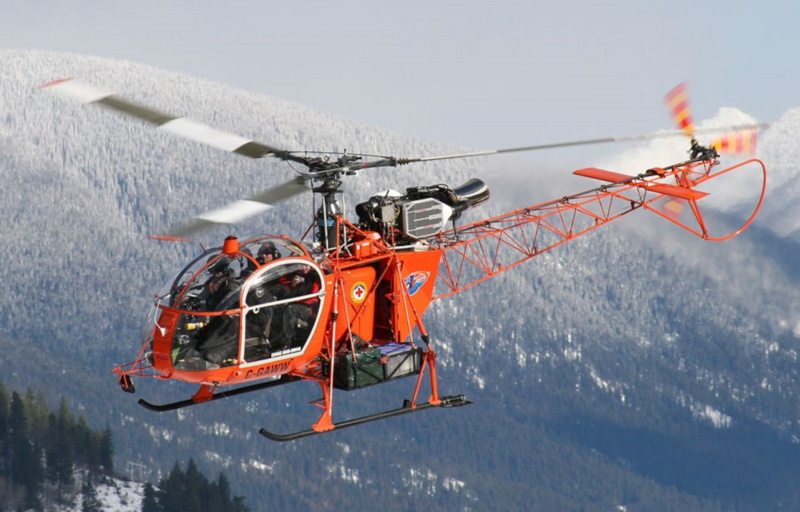
The Lama was produced both by Aerospatiale -- which had superseded Sud Aviation in 1970 -- and of course by HAL in India, as the "Cheetah". HAL assembled the first Cheetah from an Aerospatiale-provided kit in 1972, with local content increasing until fully Indian-built machines began to be rolled out in 1976:1977. The Lama was also assembled from Aerospatiale kits by Helibras in Brazil, with the machine being sold regionally under the name of "Gavaio".
The Lama had outstanding high-altitude performance, with one Lama setting long-standing records in 1972, performing a landing and take-off at 7,500 meters (24,600 feet), and reaching an altitude of 12,440 meters (40,800 feet). It could also lift a sling load of 1,000 kilograms (2,200 pounds).
* HAL found business with the Lama / Cheetah so good that in the late 1990s the company even offered it as a cheap and definitely light attack helicopter, the "Lancer". It was basically a Lama / Cheetah with a stores outrigger on each side that could carry a pod with a single Belgian FN Herstal 12.7-millimeter (0.50-caliber) machine gun and three 70-millimeter (2.75-inch) unguided folding-fin rockets, for a total of two machine guns and six rockets. A gunsight was fitted for the pilot. A total of 35 kilograms (77 pounds) of armor was added, and the nose of the canopy was reprofiled, with some panels replaced with armor.
The driver for the Lancer program was the Indian Army, which needed a light armed scout helicopter, as well as for a casualty evacuation machine that could defend itself -- pending delivery of the new, much more formidable HAL Dhruv twin-engine helicopter. A batch of a dozen Lancers was ordered initially by the army, with several dozen more Cheetahs already in service upgraded to the Lancer configuration. The Lancer has seen combat against insurgents in northern India. A few were also obtained by Nepal.
* In 2003, HAL flew a Lama / Cheetah fitted with a modern Turbomeca TM333-2M2 turboshaft with full authority digital engine control (FADEC), the updated machine being named the "Cheetal". While the TM333-2M2 is a more powerful engine than the old Artouste IIIB, since the rotor system remained unchanged, there was no real improvement in the helicopter's basic performance specs. However, the Cheetal was able to maintain its performance to substantially higher altitude, while the TM333-2M2 was easier to maintain, more fuel efficient, and in particular lighter than the Artouste IIIB, meaning a clear increase in payload. The TM333 series is also used in the Dhruv helicopter, made logistics simpler for the Indian military.
The Indian military obtained ten Cheetals, apparently new-build machines, with initial deliveries in 2009. The service has expressed interest in upgrading existing Cheetahs in service. Of course, the Lancer could be "up-engined" with the TM333 as well.
* HAL has also offered improvements to the Alouette III / Chetak. In 2005, HAL flew another demonstrator that not only had a TM333 engine, but also a full glass cockpit. This machine was named the "Chetan" and was painted in striking red and gold colors. HAL has considered further improvements, such as composite assemblies to reduce maintenance and weight. Nobody seems to have bought off on such upgrades yet.
* Over 1,300 Alouette IIs were built before end of production in 1975; add to that over 600 SA 315B Lamas to end of French production in the 1990s, with about two-thirds of the Lamas built in France and one-third built by HAL in India, with production continuing in India. Other major users included:
Alouette IIs were obtained in small numbers by civil and military users in about 50 other countries.
* Over 1,450 Alouette IIIs were built in France up to end of production in 1985, with HAL producing at least 320 more and, again, production continuing in India. Of course, France and India were major users of the type. A portion of India's Alouette III / Chetak fleet was assigned the anti-armor role, being fitted with a sighting system and four Matra Milan anti-tank missiles on stores outriggers.
IAR of Romania built about 230 IAR 316B helicopters up to the collapse of the old Communist state early in the 1990s. Most of the Romanian Alouettes served with the Romanian military, though it seems a portion were exported. Romanian Alouette IIIs could be fitted with an optical sight and carry four Soviet-designed 9KL11 Malyutka / NATO AT-3 Sagger wire-guided anti-tank missiles, or 57-millimeter unguided rocket pods. The Romanians even built three prototypes of a two-seat gunship derivative of the Alouette III, the "IAR-317 Airfox", but it did not enter production.
South Africa obtained 118 Alouette IIIs from 1962 into the 1970s, making extensive use of them in the bush fighting in the region. Alouette IIIs with twin FN MAG 7.62-millimeter machine guns were used as "G-Car" assault transports, while Alouette IIIs with a single 20-millimeter cannon -- firing both high-explosive and armor-piercing rounds -- were used as "K-Car" gunships. The Alouette III was used for medevac, search and rescue (SAR), and scouting missions as well.
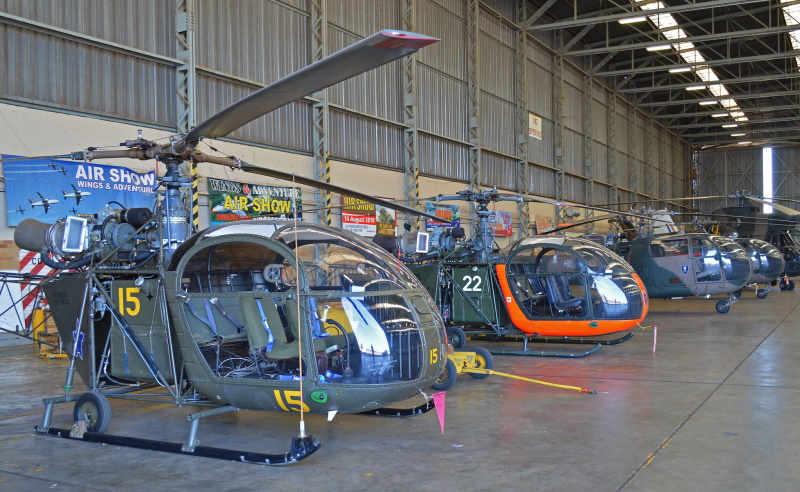
Rhodesia used the Alouette III in similar configurations and with considerable interoperation with the South Africans. South Africa phased its last Alouette III out of military service in 2006. Other substantial users of the Alouette III included:
As with the Alouette II, the Alouette III was adopted in small numbers by users in dozens of other countries. The Alouette III was such a familiar sight in Africa and African conflicts that some, only half-jokingly, called it the "Huey of Africa", after the extremely popular Bell UH-1 helicopter.
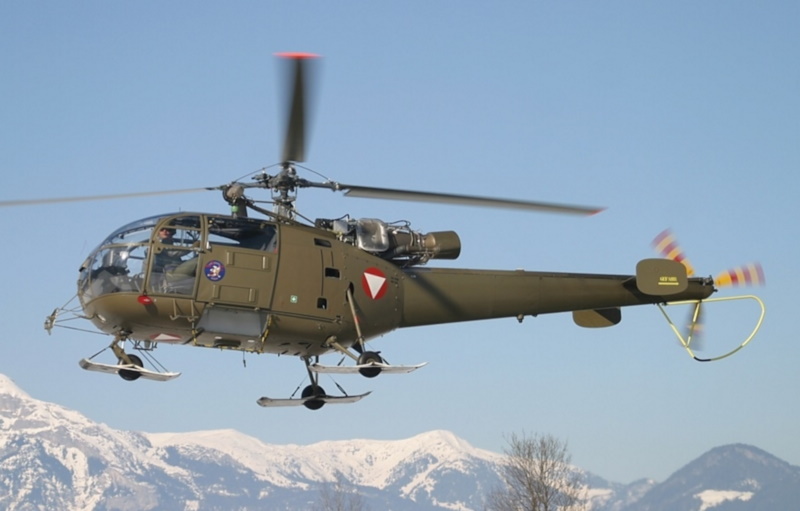
* The Alouettes are clearly past their prime in the 21st century and are fading out of service, but HAL's continued production of the Lama / Cheetah and Alouette III / Chetak, as well as company upgrades, demonstrates the persistence of this highly successful line of helicopters. There was consideration from 2008 of even developing a "Naval Rotary Unmanned Air Vehicle (NRUAV)" for the Indian Navy, based on refurbished Chetak airframes, fitted with a search radar, an imaging turret, electronic intelligence kit, and defensive countermeasures.
Demonstrators were flown to evaluate the robot flight control system and other avionics, but the navy's interest then moved on to an NRUAV based on the much more modern and capable HAL Dhruv helicopter, with the NRUAV story fading out after 2010. That would seem to have been the end of the matter -- but in 2017, an announcement was made that the Chetak NRUAV program had been revived, though little has been said about it since then.
BACK_TO_TOP* From the mid-1960s, the Alouette series was beginning to show its age, and so increasing thought was given to a follow-on to replace it. One of the drivers for this effort were requirements from the French military for improved helicopters; the British military had similar requirements, and so in February 1967 Sud Aviation and Westland of the UK signed an agreement to collaborate on the development of helicopters for their military forces.
The collaboration focused on three helicopters. Westland was the design leader for a medium helicopter originally designated "WG.13", which would emerge as the "Lynx". Sud Aviation was the design leader for a large helicopter, which would emerge as the "Puma", and for a light helicopter, the "X 300". All three helicopters would prove very successful.
The X 300 was conceived as a modernized follow-on to the Alouette III. Initial flight of a demonstration prototype, designated "SA 340", was on 7 April 1967, with this machine using an Alouette rotor system and Astazou II engine. A second SA 340 prototype followed, performing its first flight on 17 April 1968, this machine being much closer to production specification. The second machine featured a new three-bladed rotor featuring fiberglass composite blades, as well as a "fan-in-tail" or "fenestron" tail rotor, in the form of a 13-bladed fan embedded in a large tailfin.
The new rotor system had been leveraged from a technology transfer agreement with Messerschmitt-Boelkow-Blohm (MBB) of Germany, and trialed on an SA 318C Alouette II in 1966. The fenestron configuration improved safety to a degree, the helicopter tail rotor always having been a deadly threat to the careless during ground operations; the ducted fenestron configuration was also quieter as well as more efficient than a traditional tail rotor, with a power savings of about 5%. There was thought early on that the fenestron fan could be turned off in forward flight for even greater efficiency, with the tailfin canceling main rotor torque, but that idea didn't work out in practice.
A preproduction machine, with a stretched fuselage and various fixes relative to the SA 340 prototypes, flew in July 1971, being designated the "SA 341 Gazelle". Production of the Gazelle began in August 1971, with the machine built by both Aerospatiale in France and Westland in the UK.
* The Gazelle was clearly a descendant of the Alouette III, featuring a full fuselage, three-blade rotor, single turboshaft engine behind the rotor mast, and tailplane with tailfins on the end. The Gazelle was, however, effectively a new design, with little or no parts commonality with the Alouette III. The Gazelle was sleeker and much more modern in appearance, particularly with the fenestron tail fan. It abandoned the Alouette III's tricycle wheeled landing gear and reverted to landing skids. Wheels could be fitted to the skids for ground handling.
The Gazelle was powered by a Turbomeca Astazou III-series turboshaft providing 440 kW (590 SHP). The main rotor blades could be manually folded, and a rotor brake was standard. There was a wide front-hinged door forward and a small back-hinged cargo door to the rear on each side. Normal accommodations were two seats in front and a three-position bench seat in back. The rear bench seat could be folded flat into the floor to make space for cargo. With the rear bench seat folded and the front left seat removed, two stretchers could be installed on the left in a "stacked" configuration, with a seat added for a medical attendant. There was a baggage compartment at the rear of the passenger compartment.
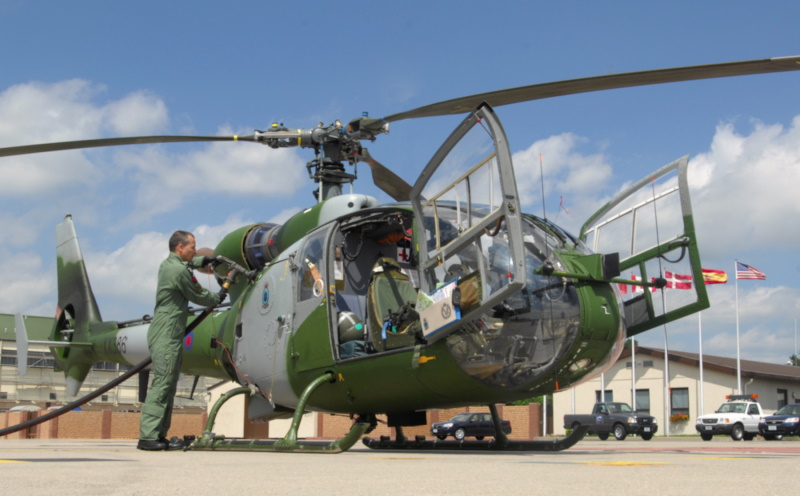
The Gazelle could haul an external sling load of 700 kilograms (1,540 pounds). Dual controls were optional, as was float or ski landing gear, and a rescue hoist with a lift capacity of 135 kilograms (300 pounds).
___________________________________________________________________
AEROSPATIALE SA 341 GAZELLE:
___________________________________________________________________
main rotor diameter:
10.5 meters (34 feet 2 inches)
fenestron diameter:
69.5 centimeters (2 feet 4 inches)
fuselage length:
9.53 meters (31 feet 3 inches)
footprint length:
11.97 meters (39 feet 2 inches)
height (rotor head):
2.72 meters (8 feet 11 inches)
height (tailfin):
3.18 meters (10 feet 5 inches)
empty weight:
920 kilograms (2,030 pounds)
max loaded weight:
1,800 kilograms (3,970 pounds)
maximum speed:
265 KPH (165 MPH / 140 KT)
service ceiling:
5,000 meters (16,400 feet)
hover ceiling (in ground effect):
2,850 meters (9,350 feet)
hover ceiling (out of ground effect):
2,000 meters (6,550 feet)
range (normal load):
670 kilometers (415 MI / 360 NMI)
___________________________________________________________________
Seven variants were introduced at the outset:
The British Gazelle AH.1s were originally unarmed, but they were rigged with unguided rocket pods for combat use in the 1982 Falklands conflict. Later in the 1980s, about 70 AH.1s were fitted with a roof-mounted GEC-Ferranti AF532 optical sighting system for the scout / targeting role, and after that some survivors were fitted with a "direct voice input" command system.

The French Army obtained 170 SA 341Fs. These machines generally ended up being modified to three different configurations:
Gazelles could be fitted with an upturned exhaust diffuser to reduce the Gazelle's infrared signature from heat-seeking missiles. Photos suggest this was something of an unusual fit, however. Some Gazelles were later updated with the advanced composite rotor blades of the Aerospatiale Ecureuil helicopter.
* Aerospatiale became interested in the idea of fitting the Gazelle with a more powerful engine for "hot & high" operation, such a machine being potentially useful for French military operations in Africa and for sales to Middle Eastern customers. That interest led to the construction of a prototype for the "SA 342" -- powered by a Turbomeca Astazou XIV turboshaft providing 640 kW (860 SHP) -- which performed its first flight on 11 May 1973.
Production began with the "SA 342J" civil variant and the "SA 342K" military export variant, with the SA 342K being quickly revised to the "SA 342L" featuring an improved fenestron system. The French Army obtained a variant of the SA 342L designated the "SA 342M", featuring an Astazou XIVM engine plus fit of an M397 optical sight, with this variant able to carry four HOT missiles. The SA 342M also featured an autopilot and a Sextant Nadir navigation system. The British never built or obtained the SA 342, having no outstanding need for the improved performance.
200 SA 342Ms were delivered from 1980. They were upgraded in the 1990s with a Viviane night-capable sighting system, to be known as "SA 342M1 Gazelle Viviane"; these machines were easily identifiable because the boxy Viviane sight was clearly bigger than the old optical sight.
During the 1991 Gulf War, 30 of the French Army SA 342M machines were modified to an anti-helicopter configuration, carrying twin Matra "Air To Air Mistral (ATAM)" light air-to-air missiles (AAMs), and known as "SA 342M Gazelle Celtic". Gazelles were later more formally updated to carry four ATAMs as the "SA 342L1 Gazelle ATAM". Armed Gazelles are being phased out in favor of the Eurocopter Tiger gunship helicopter, but it seems plausible the tidy, agile, and well-liked Gazelle will survive in French service in the utility role for some time.
BACK_TO_TOP* Westland production of the Gazelle ended in 1984, with 294 machines built, 282 of them going to the British military. In the early 1990s, Aerospatiale's helicopter operation was consolidated with MBB of Germany to form "Eurocopter", which would later become part of the "European Aerospace & Defense Systems (EADS)" group -- which still later became the "Airbus" group, with Eurocopter becoming "Airbus Helicopter". However, the Gazelle wouldn't remain part of the Eurocopter product line for long, being phased out of production in the mid-1990s. Over 1,250 had been built in France and Britain up to that time.
British Gazelles participated in the Falklands War in 1982, with three lost in action. British and French Gazelles saw a fair amount of action in the 1991 Gulf War. The British used theirs as scouts for other attack platforms, while the French used their HOT-armed Gazelles to take on Iraqi armor with fair success. Britain is now working to replace their last Gazelles, with the type to be completely out of service no later than 2025.
The French also employed Gazelles in their string of interventions in African nations -- including Chad, Djibouti, Somalia, and the Cote d'Ivoire -- but the combat history of these interventions is obscure.

SOKO in Yugoslavia built the Gazelle under license, producing the SA 341H, SA 341L, and SA 342L until production was curtailed in 1991 by the disintegration of the Yugoslav federation in a sequence of ugly little wars. Yugoslavian Gazelles had Soviet-type armament options, for example four 9KL11 Malyutka (NATO AT-3 Sagger) wire-guided anti-tank missiles -- with the appropriate sighting system mounted above the cockpit -- or two 9K32 Strela-2 (NATO SA-7 Grail) AAMs for the anti-helicopter mission. After the breakup of Yugoslavia, most of the Yugoslavian Gazelles ended up in the hands of the Serbs, who used them extensively in the fighting during the Balkans Wars. Other substantial users of the Gazelle included:
The Gazelle was used in small numbers by the military forces of dozens of other nations. Two Gazelles, in military colors but unmarked, were spotted in Mozambique in 2019, presumably being in service to a mercenary organization. The Gazelle was also popular in the international civilian market. One SA 341G civil Gazelle was dummied up with a gunship-like cockpit to star in the 1984 movie BLUE THUNDER.
Aerospatiale fitted one SA 342 with wings for use as a compound helicopter demonstrator, with this machine designated "SA 349". The Gazelle is past its prime, but is likely to remain in service for decades.
* Alouette II variants included:
Alouette III variants included:
Gazelle variants included:
* While the USA has become a better market for European helicopters than it used to be -- with Eurocopter machines like the Ecureuil and BK 117 being nothing particularly exotic here -- it seems that in the days of the Alouette and Gazelle that "buy American" was much more the rule, and it is difficult to even find museum displays of these machines in the USA. As the old Alouettes and Gazelles are retired, hopefully they should become better represented, and even make appearances in airshows.
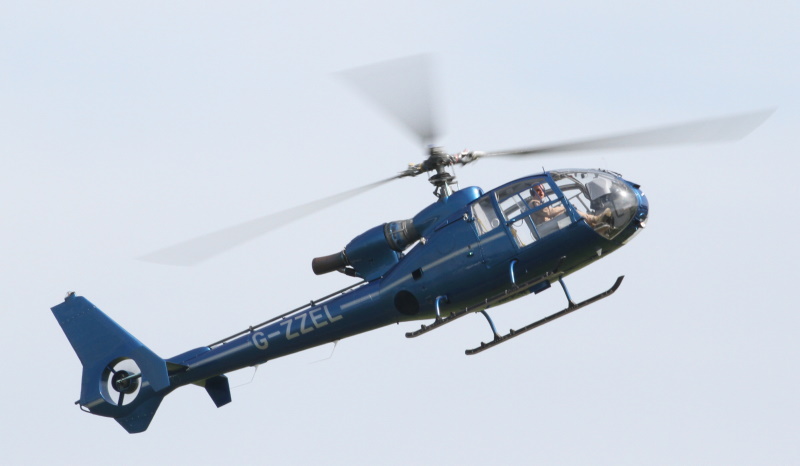
* People are not all that interested in helicopters, and so they are not particularly well documented. As a result, I had to cobble this item together from what I could scrounge up from various aircraft encyclopedias that I wouldn't normally rely on, like David Donald & John Lake's 2000 ENCYCLOPEDIA OF MILITARY AIRCRAFT, as well as various JANE'S ALL THE WORLD AIRCRAFT that I could get my hands on from local libraries.
I also hunted through online sources and my set of old WORLD AIR POWER JOURNAL and INTERNATIONAL AIR POWER REVIEW (IAPR) magazine. To my surprise, volume 17 of IAPR actually had a detailed article on the Lancer and other HAL Alouette improvements. I think the final document here is not so bad, but also not so trustworthy since it's been thrown together from bits and pieces.
The lack of thorough sources was why I didn't try to list all possible Alouette / Gazelle users in this document. Not only would it have considerably increased the length of the document and reduced its readability, trying to get reliable information on every possible user would have been a nightmare, particularly in tracing retirements or transfers of helicopters from one user to another. I decided to only discuss specific users when they obtained at least ten machines.
* Illustrations details:
* Revision history:
v1.0.0 / 01 jan 10 v1.0.1 / 01 mar 10 / NRUAV comments. v1.0.2 / 01 jul 10 / Minor fixes. v1.0.3 / 01 feb 12 / Review & polish. v1.0.4 / 01 jan 14 / Review & polish. v1.0.5 / 01 dec 15 / Review & polish. v1.0.6 / 01 nov 17 / Review & polish. v1.0.7 / 01 nov 19 / Review, update, & polish. v1.0.8 / 01 sep 21 / Review, update, & polish. v1.0.9 / 01 aug 23 / Review, & polish.BACK_TO_TOP
